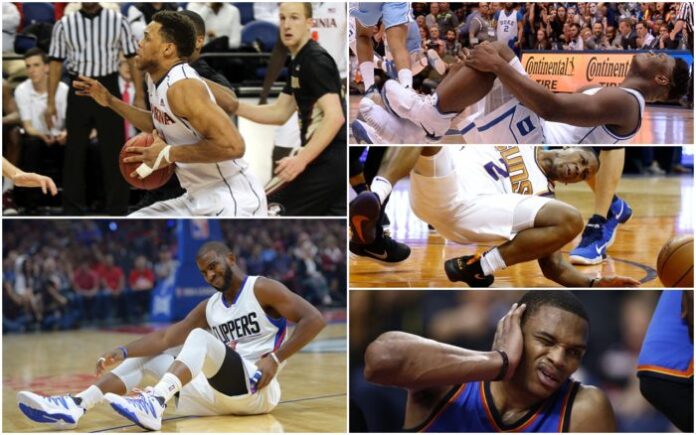March Madness is upon us and not even Covid-19 can decrease the euphoria that accompanies college basketball teams in the month. Everyday people also show an increased interest in playing/watching basketball during the month. As a matter of fact, you might be playing basketball right now.
However, you need to look out for yourself because basketball is one of the most injury-ridden sport. How many times have we heard famous basketball players sidelined because of multiple injuries? Very often.
Thankfully we are going to look out for you (in a way).
We took a look at 5 of the most common basketball injuries according to a report by Hospital for Special Surgery. Obviously, as it is common in other sports, tweaks, strains, and general muscle trauma will be the most common catalyst of injuries. Let’s dig deeper into what type of injuries playing basketball might cause you and how to prevent it.
1. Foot & Ankle Injuries

As a whole, dribbling combined with constant jumping Is a recipe for disaster for your foot and ankles. Not to mention freak accidents such as rolling your ankle, stepped on, and weird foot landings when dribbling. The lower extremities are the black sheep of most sports injuries.
All studies in both Europe and the US have shown this to be the leading basketball injury. It simply consists of making an outward or inward movement of the foot, which exceeds the tension endurable by the ankle ligaments, causing injuries to them. Thus, with any action on the court, this problem may appear. The sprain can be up to three different degrees from lowest to highest severity:
Plantar Fasciitis injuries will also cause problems if you are looking to play basketball. It consists of painful inflammation of the plantar fascia, which runs throughout the sole of the foot.
It can be caused mainly by landing too hard on hard surfaces or having the Achilles tendon too tight, among the possible causes of a basketball player. However, the frequent cause is the lack of strength and endurance, that is why the longer you play basketball the higher risk you will have of getting plantar fasciitis.
Prevention: The name of the game in avoiding any type of injury is prevention. As for avoiding ankle and foot injuries the number one thing you should do is make sure the area is covered with the right footwear. There are specially designed basketball shoes for playing both indoors or outdoors. Wrapping your ankles with athletic tape is also a common prevention method for people looking to avoid injuries or people with existing ankle injuries. Combing both methods will give you enough ankle/foot support.
2. Hip & Thigh Injuries

Any activities when playing basketball will put tremendous strain on our legs and hips, and if you don’t have enough strength and endurance in those body part then you will be prone to hip strains and muscle/ligament tears.
Prevention: Increasing strength and endurance in your legs will be the best way to avoid any leg injuries in general. Being flexible is almost as important though, so make sure to stretch before and after playing basketball to minimize the risk of injuries. Having srong and flexible legs will decrease the chance of hyperextension and leg injuries as a whole.
3. Knee Injuries

Severe injuries like ACL/MCL/LCL tears are one of the most difficult injuries in this sport but luckily they don’t happen that often. Even so, a lot of basketball players suffer from bad knees and pain in this area. The most popular knee supports for basketball players suffering from this overuse injury are knee straps and knee braces that players normally wear just below the kneecap. Usually these knee braces could be brought from Aidfull.com at discount price.
Meniscus injuries is also something that you need to look out for. These cartilaginous tissue discs are located below the knee joint (between the femur and the tibia) and act as shock absorbers. So if you have a compromised meniscus the risk of getting another type of knee injuries will increase
If it is a medial meniscus injury, it can also damage the internal lateral ligament. On the other hand, if it happens in the lateral meniscus, there are no more injuries. Pains and instability are noted in these cases.
The main cause is usually a sudden or strange turn with the firm foot on the ground.
Prevention: Squats and lunges will help you maintain strong and flexible knees for playing basketball. As usual, make sure to stretch before & after a session. Wearing a knee brace is also a good precaution for people with existing knee injuries.
4. Wrist & Hand Injuries

You would expect wrists and hands to be the most affected body parts of basketball players, but they are not.
Obviously, with this sprain, we mean the hand, which is an essential part of the game. Thus, the interphalangeal joints, where up to three phalanges are found per finger, can suffer ligament injuries.
In its three different degrees (from just hyperextension to rupture) stiffness, inflammation and pain arise instantly and can even generate a bruise.
The main cause is a bump or your finger getting caught in an unnatural motion.
Prevention: Sadly there are limited amounts of exercises that you can do to strengthen your hands and wrist. In this case, the best prevention would be avoiding any situation where your hands are susceptible to injuries. This means being completely aware and alert when playing basketball. You can wear a wrist brace but there is only so much that it can do.
5. Head & Face Injuries

Hitting your head is not a fun experience in any way shape or form. Despite what some people said there are still great risks of head injuries in basketball. Being hit on the head by an elbow or ball can result to minor concussions. If not treated it will make your quality of life decrease significantly. Forget playing basketball if you have major brain trauma.
Prevention: Being concussed is not pleasant. But if you wear a helmet when playing basketball you will look out of place. Avoiding any contact to the head from either the ball or other players is the only thing you can do to prevent head injuries (sadly)
Prevention Overview
Check with your doctors before even deciding to play basketball.
Hydration is key – Staying hydrated will make you more alert of any danger of injuries while playing.

Check the weather – Playing outdoors while the sun is burning is not very ideal, neither is playing when its raining, be sensible.
Strength is key – Having adequate strength in the muscle will decrease the chance of getting an injury.
Build slowly – If you never played basketball before then you need to start slow and not rushing to play every day, give your body time to adapt to the stress.
Skip training – If you are a professional basketball player you will need to take the odd day off every now and then. Listen to your body, you might want to continue training but there are benefits of taking days off when you need it most. Not to mention you might have an existing injury that needs to be treated before the big game. Take some days off and you will be better off in the long run.





![Calgary’s Hottest Neighborhoods for Luxury Homebuyers [2024]](https://thewashingtonote.com/wp-content/uploads/2024/04/Calgary-324x160.png)



